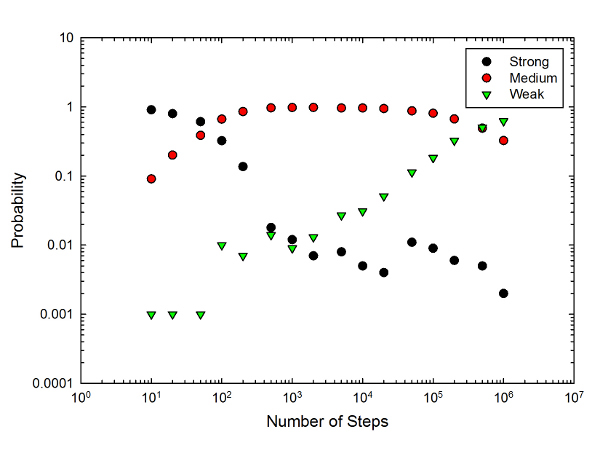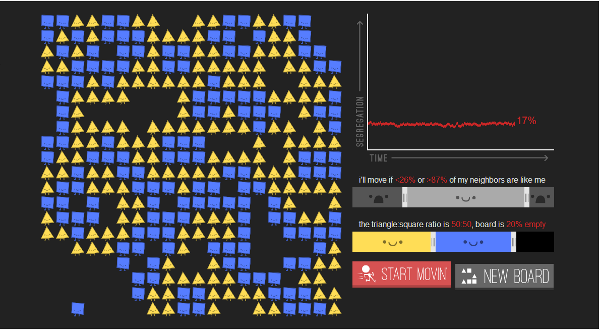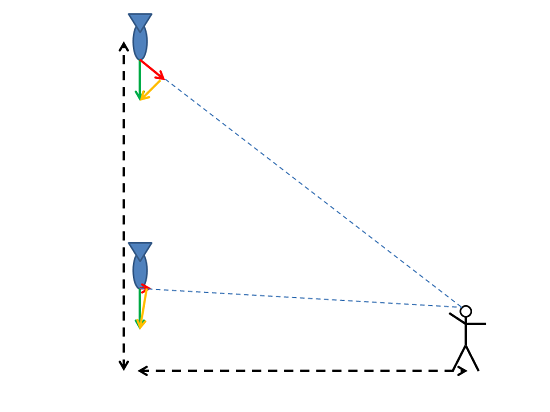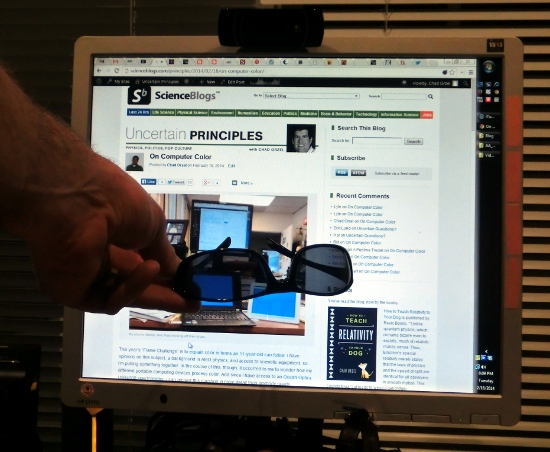Last week, I did a post for Forbes on the surprisingly complicated physics of a light bulb. Incandescent light bulbs produce a spectrum that’s basically blackbody radiation, but if you think about it, that’s kind of amazing given that the atoms making up the filament have quantized states, and can absorb and emit only discrete… Continue reading Crude Monte Carlo Simulation of Light-Bulb Physics
Category: Computing
Diversity Is Frustrating: Cartoon Polygon Physics
Back in December, The Parable of the Polygons took social media by storm. It’s a simple little demonstration of how relatively small biases can lead to dramatic segregation effects, using cute cartoon polygons. You should go read it, if you haven’t already. I’ll wait. This post isn’t really about that. I mean, it is, but… Continue reading Diversity Is Frustrating: Cartoon Polygon Physics
Quantum Optics: The Game
Over on Facebook, my colleague Chris Chabris was talking up a smartphone game from a company he’s associated with. Which of course got me thinking “Wait, why don’t I have a smartphone game company?” (The Renaissance Weekend is also partly to blame, as I was one of about six people there who didn’t have a… Continue reading Quantum Optics: The Game
PNAS: Benoit Hamelin, Computer Security Developer
I’ve decided to do a new round of profiles in the Project for Non-Academic Science (acronym deliberately chosen to coincide with a journal), as a way of getting a little more information out there to students studying in STEM fields who will likely end up with jobs off the “standard” academic science track. The eleventh… Continue reading PNAS: Benoit Hamelin, Computer Security Developer
PNAS: P., Web Developer
I’ve decided to do a new round of profiles in the Project for Non-Academic Science (acronym deliberately chosen to coincide with a journal), as a way of getting a little more information out there to students studying in STEM fields who will likely end up with jobs off the “standard” academic science track. Fourth in… Continue reading PNAS: P., Web Developer
PNAS: Fran Poodry, Educational Technology Specialist
I’ve decided to do a new round of profiles in the Project for Non-Academic Science (acronym deliberately chosen to coincide with a journal), as a way of getting a little more information out there to students studying in STEM fields who will likely end up with jobs off the “standard” academic science track. Third in… Continue reading PNAS: Fran Poodry, Educational Technology Specialist
PNAS: Bob Cross, Naval Computer Scientist
I’ve decided to do a new round of profiles in the Project for Non-Academic Science (acronym deliberately chosen to coincide with a journal), as a way of getting a little more information out there to students studying in STEM fields who will likely end up with jobs off the “standard” academic science track. Second in… Continue reading PNAS: Bob Cross, Naval Computer Scientist
PNAS: W. F., Patent Lawyer
I’ve decided to do a new round of profiles in the Project for Non-Academic Science (acronym deliberately chosen to coincide with a journal), as a way of getting a little more information out there to students studying in STEM fields who will likely end up with jobs off the “standard” academic science track. First up… Continue reading PNAS: W. F., Patent Lawyer
The Sound of Simulated Bombs
So, last week I idly wondered about the canonical falling-bomb whistle. The was originally intended to be a very short post just asking the question, but I got caught up in thinking about it, and it ended up being more substantial. And leaving room for further investigation in the form of, you guessed it, VPython… Continue reading The Sound of Simulated Bombs
Computers and Shades
In comments to the post on computer display colors, Will Slaton notes that Mac displays emit polarized light. And, indeed, this is an inherent part of the backlit LCD technology– the individual pixels are bits of liquid crystal between two polarizers, and an applied voltage causes the liquid crystal molecules to flip between a state… Continue reading Computers and Shades



